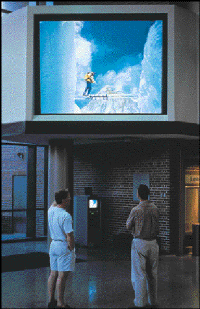Daniel C. McCarthy, News Editor
Innovative technologies take the spotlight at Boston's Museum of Science, where waves of ambient natural light flow through the modern glass-walled foyer. Although this light can create an open atmosphere, it can also create problems for visitors trying to view information on the wall-mounted displays, which are backlit by cathode-ray tubes. In keeping with its overall theme of cutting-edge applied science, the museum found a solution to its problem with ColorVision laser display technology from the Corporation for Laser Optics Research, known also as Color.

A laser-illuminated display at Boston's Museum of Science exhibits real information on the museum's daily events, but it also showcases innovative technology. Also, unlike cathode-ray tube displays, the laser display's color is resistant to the abundant natural light in the glass-walled foyer.
"Color's display is something to be used to display real information, but it also showcases innovative technology," said Brian Worobey, vice president for information technology at the museum. The laser color display still competes for attention with cathode ray-tube displays showing information on shows, but Worobey said the foyer's generous ambient light tends to wash out the colors on the cathode-ray displays.
Aside from ambient light problems, the museum had also been searching for a more vibrant medium with which to frame daily events. Part of this entailed replacing tape-based presentations on the screens with computer MPEG formats. "The laser display makes it possible for this to be big, bold and attention-grabbing," said Worobey. "Could we have done it with [cathode-ray tubes]? Perhaps. One of the things I like about ColorVision is it really is bright and attracts people to it. It's just not the same effect with a TV."
The museum selected the 7.5 × 10-ft CV1101 model display, which combines the output of solid-state red, green and blue lasers to backlight the screen. The light from each lamp-pumped laser is divided into microbeams before an acousto-optical modulator integrates them with an input video source. A scanning mirror directs the encoded beams onto the screen one line at a time.
Although the laser display uses a comparatively powerful 5-W blue laser, Color recently announced it will upgrade its next-generation displays with a 40 percent brighter 7-W version.